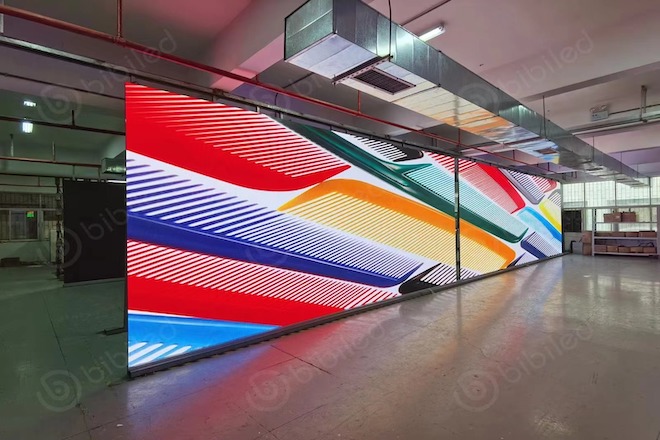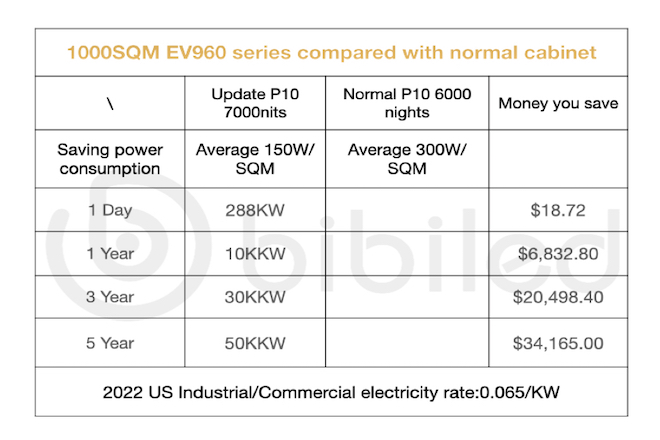Different power consumption indicators explained?
How to calculate LED display power consumption for indoor and outdoor SMD LED screens?
How to reduce my giant screen’s power consumption?
Does an energy-saving LED display save electricity costs for you?

If you plan to buy an LED display screen, power consumption is a decisive parameter; you need to care about it; why?
Low power consumption levels mean low power bills. So, you should look at the power consumption information to make the right buying decision.
1. Different power consumption indicators explained?
The only things that can measure power consumption are maximum value, black level, and standby power consumption.
- Maximum power consumption
The LED display needs to light up each lamp bead, and at the same time the white screen is displayed, the brightness is adjusted to the highest so that the power reaches the maximum value.
The power consumption measured this way is your product’s maximum power consumption specification.
- Black level power consumption
Black level power consumption refers to the power required to operate the electronic equipment without displaying content on the LED wall; in other words, the energy that the driver and receiver cards are still consuming even when the LED screen is not lit.
- Standby power consumption
When the LED wall is set to standby, it still requires a certain amount of power to continue working even in power-saving mode.
Standby power consumption is lower than black level power consumption but still significantly higher than when the display is completely off.
2. How to calculate LED display power consumption for indoor and outdoor SMD LED screens?
The traditional industry rule of thumb (divide the maximum power consumption by three) usually does not consider average usage and black level power consumption, for today’s high-resolution LED display products, black level power consumption has become an important parameter that cannot be ignored.
BIBILED power consumption is calculated based on black level power consumption, maximum power consumption, and average usage of the LED wall, with the display configured at 70% of its maximum brightness, while typical content on the wall consumes only 33% of that power.
In the above calculation, in this calculation, we assume that the content only consumes 33% of the configured power; it all depends on the application area and the typical content displayed on display.
For example:
an LED display is installed in the bank’s lobby, with white background showing the bank logo and the exchange rate value of today’s countries to inform customers that because white requires more LED power, the average power consumption of this content will be higher than 33%.
There is also a case where an LED wall is installed at the restaurant entrance, with a black background and red text to welcome the arrival of diners, and the average power consumption will be lower than 33%.
3. How to reduce my giant led screen‘s power consumption?
The higher the working brightness of the LED display, the higher the power consumption, especially in the case of strong sunlight outdoors; to display the content more clearly, the LED display needs higher brightness.
And at night, the brightness of the display can be greatly reduced, thereby reducing power consumption.
We can use the following 2 effective methods to control the power consumption of the led screen:
- Reasonable planning of time
You can manage when the LED display turns on and off through the software’s application, you can program the brightness of the screen according to the time of day and season, always providing the best visual quality, such as daytime and brightness settings night, etc.
- Use a light sensor
If you install a light sensor on an outdoor LED large screen, it is a light-sensitive device used to measure the brightness of the screen environment, this method is better than the first method, mainly because the light sensor can fully automate the adjustment of the screen; of course, fine-tuning can also be done manually, such as setting behavior curves and brightness thresholds.
4. Does Energy-saving LED Display save electricity costs for you?
Today, energy-saving LED displays are a trend in the LED display industry, this type of LED screen is suitable for various applications of fixed LED display and rental LED display, but customers also raised some questions – can this LED display save electricity bills, and how much can it save you?
First of all, the answer is yes; the long-term application of energy-saving LED displays can save much money.
How do we conclude? Just check out the charts listed below.

Let’s take the BIBILED series LED display as an example.
We can see that an energy-efficient LED display can save you much money in the long run, thereby increasing your ROI on your LED screen project.
Conclusion:
The above explains the knowledge about the power consumption of the LED display. If you want to know how the electricity bill of the single-color, outdoor two-color, and full-color LED display is calculated? Click to find out: How much electricity cost do we need to pay for our LED display?
If you have any questions about the LED display screen, you can leave a message below or email us; we will reply to you as soon as possible.
